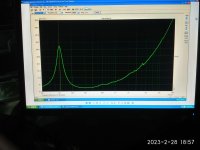I've been working on a set of speakers for a bit. Finally settled on the drivers, amp, etc. I was reading up on dampening materials and I'm a little lost. Are you just trying to make the inside of the enclosure an anechoic chamber? Or is it more about attenuation specific frequencies? Also, would lining the inside change the functional behavior of a PR?
Different kinds of boxes require different approaches to damping.
The end goal is to help minimize internal reflections from coming back thru the cone.
A sealed box is usually filled with something like poly fluff, reflex enclosures (ie with a PR) are usually just lined as the damping will reduce the affect of the helmholz resonator.
dave
The end goal is to help minimize internal reflections from coming back thru the cone.
A sealed box is usually filled with something like poly fluff, reflex enclosures (ie with a PR) are usually just lined as the damping will reduce the affect of the helmholz resonator.
dave
So would that mean that, with proper dampening, a PR wouldn't even be needed? Or does that just mean I need to be more judicious in placing it?A sealed box is usually filled with something like poly fluff, reflex enclosures (ie with a PR) are usually just lined as the damping will reduce the affect of the helmholz resonator.
A PR is a venbt substitute used in situatins where a small box is tuned low and it would not be possible or make sense to do a vent as long as needed.
I am not a fan.
dave
I am not a fan.
dave
Cabinet walls might also need damping to reduce vibration. It is achived by some damping material similar to what is used for cars. Bitumen sheets or bitumenous felt IIRC. There might be more modern materials today, similar to Blu-Tac. Vibrating walls could color the sound by boosting some frequencies.
The speaker is going to be on the small side. Which means will definitely need PRs. But if lining the speaker will hamper the functionality of the PRs... what now? lol. Also why don't you like them?I am not a fan.
Cabinet walls might also need damping to reduce vibration.
Box wall damping is a quite different thing and all to often counter productive.
dave
The speaker is going to be on the small side. Which means will definitely need PRs
Whaty driver are you using? What box?
dave
Use enough, but no more than necessary.But if lining the speaker will hamper the functionality of the PRs... what now?
I'm going to use 2 6.5" purifi aluminum woofers and a kef coaxial in pseudo mtm. Am going to make a little chamber for the coaxial and port it out the back. The initial idea was, other than the whole lining thing, to make two braces as to chamber off each 6.5" driver. The rest would be rock wool fill.Whaty driver are you using? What box?
...thanks bud. Appreciate you.Use enough, but no more than necessary.
Some of us use the click test to decide how much lining or stuffing is 'just enough'. Normally for damping vents, but works just as well on sealed or if using proper measurement gear, then an impulse response can dial it in to technical perfection.

Last edited by a moderator:
I don't mean the click test itself. It mentions "use a computer program to measure impedance" so that's what I was wondering about. I can definitely wire a switch, a battery, and a resistor if all else fails 😛No mic, no software.
Last edited:
Do it the same as you would using an oscilloscope and a signal generator, except the computer takes the place of both. If unsure, try REW or ARTA since there are plenty of current users.
Well since sig-gens and o-scopes are prohibitively expensive, REW it is! lolDo it the same as you would using an oscilloscope and a signal generator, except the computer takes the place of both. If unsure, try REW
How somebody know what is enough but no more?Use enough, but no more than necessary.
I haven't took a definite answer when i had measured mine Asathor.
I have used ARTA for impedance measurement.
What is better stuffing,yellow or green?
Second picture is a free to air woofer measurement
Attachments
Last edited:
In a closed box it is OK to stuff the whole box, just to be sure. It isn't really necessary to go that far to manage modes, just a portion of each dimension will do. Also, when subs are used it is usually preferred to combine them with closed box mains.
Ported boxes are no different, but when we are trying to get more bass by going ported, it simply seems a shame to waste it.
Luckily, the damping material works better at higher bass frequencies where the modes are found, and not as well at the vent frequencies.
Ported boxes are no different, but when we are trying to get more bass by going ported, it simply seems a shame to waste it.
Luckily, the damping material works better at higher bass frequencies where the modes are found, and not as well at the vent frequencies.
- Home
- Design & Build
- Construction Tips
- Point Of Damping

